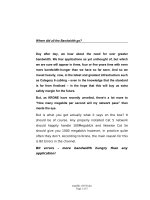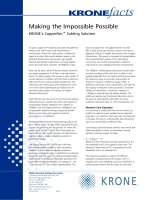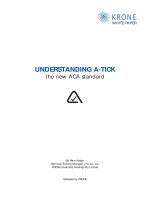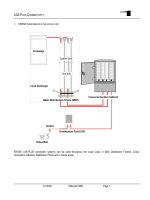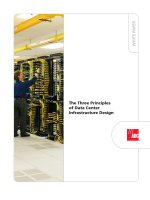KRONE - White Paper - TrueNet KUK
Bạn đang xem bản rút gọn của tài liệu. Xem và tải ngay bản đầy đủ của tài liệu tại đây (246.31 KB, 5 trang )
Where did all the Bandwidth go?
Day after day, we hear about the need for ever greater bandwidth.
We fear applications as yet unthought of, but which we are sure
will appear in three, four or five years time with even more
bandwidth-hunger than we have so far seen. And so we invest
heavily, now, in the latest and greatest infrastructure such as
Category 6 cabling – even in the knowledge that the standard is
far from finalised – in the hope that this will buy us extra safety
margin for the future.
But, as KRONE have recently unveiled, there’s a lot more to
“How many megabits per second will my network pass” than
meets the eye.
But is what you get actually what it says on the box? It should
be of course. Any properly installed Cat 5 network should
happily handle 100Megabit/s and likewise Cat 5e should give
you 1000 megabit/s however, in practice quite often they
don’t. According to Krone, the main reason for this is Bit
Errors in the channel.
Bit errors – more bandwidth hungry than any
application!
When bit errors occur. “1s” arrive as “0s”, “0s” arrive as “1s” and either
way the chunk of data that we were trying to send ends up as
garbage.
jeo1382789703.doc
Page 1 of 5
Ethernet and other protocols are thankfully not stupid and can detect
when they receive a packet of garbage.
This is OK for one or two garbled packets, but as the incidence of
garbling increases so the requests for retransmissions, and the
retransmissions themselves, become a significant but invisible part of
the network traffic. In fact they quickly become the major part of
network traffic (Table 1).
According to recent research at Krone’s labs, the major cause of these
Bit Errors is signal reflections caused by impedance changes – or
mismatches – at various points through the channel. And with the
‘Cat’ specs allowing individual components to vary from 85 ohms
impedance to 115 ohms, there’s a lot of scope for reflections and Bit
Errors.
TABLE 1
% of Retransmissions Data rate
0% 100 Mbit/s
1% 20Mbit/s
2% 4Mbit/s
3% 800Kbit/s
4% 160Kbit/s
5% 32Kbit/s (Modem speed!)
jeo1382789703.doc
Page 2 of 5
Is there a solution?
Readers who have had any dealings with radio – and after all our Cat
5 and Cat 6 systems are actually operating at VHF radio frequencies –
will know that closely matching the impedance of all elements of
the system will reduce reflected power, as well as distortion and
standing waves. This rids us of the majority of the problems, and this is
what Krone say they’ve now done.
Zero Bit Error Rate
TrueNet is a physical layer solution, impedance matched to within +/-
3 ohms throughout, both in the time domain and the frequency domain,
which exhibits such low levels of reflection, attenuation deviation and
alien crosstalk that Krone is prepared to guarantee the network to be
completely Bit Error-free for five years (in addition to the normal twenty
year warranty). Krone has even coined the term ZeBER, standing for
zero bit error rate, to describe the result!
jeo1382789703.doc
Page 3 of 5
Diagram: The reflection effect of impedance mismatch
Diagram: Impedance variation – Normal system
jeo1382789703.doc
Page 4 of 5
Diagram: Impedance variation – KRONE TrueNet system
jeo1382789703.doc
Page 5 of 5
